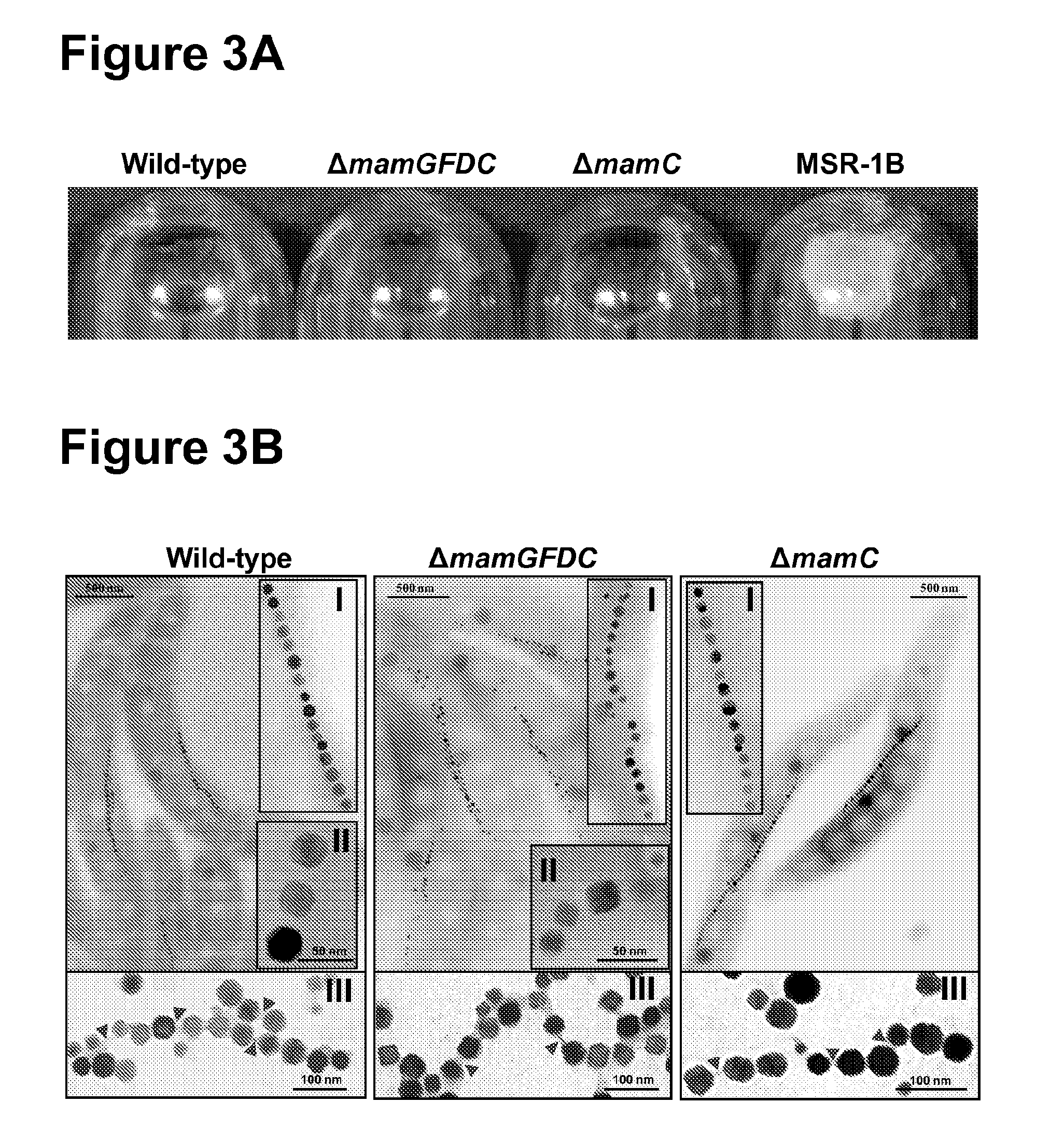Method for the recombinant production of magnetic nanoparticles
a magnetic nanoparticle and recombinant technology, applied in the direction of peptide sources, group 3/13 element organic compounds, bacteria peptides, etc., can solve the problems of insufficient application, significant hampered production of particularly dimensioned nanocrystals via these synthesis routes, and largely unknown individual functions of mmps
- Summary
- Abstract
- Description
- Claims
- Application Information
AI Technical Summary
Benefits of technology
Problems solved by technology
Method used
Image
Examples
example 1
Generation of ΔmamGFDC and ΔmamC Mutant Strains
1.1. Bacterial Strains, Media and Growth Conditions
[0075]Liquid cultures of Magnetospirillum (M.) gryphiswaldense strain R3 / S1 (Schultheiss, D. and Schüler, D. (2003) Arch. Microbial. 179, 89-94) were grown in modified FSM medium (Heyen, U. and Schüler, D. (2003) Appl. Microbiol. Biotechnol. 61, 536-544). Colonies of M. gryphiswaldense were obtained on activated charcoal agar medium (ACAM) that was incubated micro-aerobically at 28° C. (Schultheiss, D. and Schüler, D., 2003, supra). Growth experiments were carried out under micro-oxidic conditions in 1-1 flasks containing 100 ml low- or high iron containing medium. Low-iron containing medium (LIM) essentially is FSM medium lacking yeast extract and ferric citrate, whereas for high-iron medium ferric citrate was added to 500 μM to LIM. To grow magnetite free cells (no magnetic response), M. gryphiswaldense strains were passaged for three successive transfers in LIM. Optical densities and...
example 2
In Vivo Localization of Mam Proteins
2.1. Construction of EGFP-Fusions for In Vivo Localization
[0080]The EGFP protein was fused by a His-(Gly)10 peptide linker to the C-terminus of MamG, MamF, and MamD, respectively. The egfp gene (primer CL21 / CL22) was amplified from the pEGFP-N1 plasmid and cloned into the EcoRI site of the pBBR1MCS-2 to yield the plasmid pCL_EGFP expressing (Gly)10-EGFP. The amplified genes of mamC (primer CL13 / CL14), mamF (CL9 / CL10), and mamG (CL23 / CL24) were cloned into the XhoI and NdeI restriction sites of pCL_EGFP in order to generate plasmids pCL_C-EGFP (MamC-His-(Gly)10-EGFP), pCL_F-EGFP (MamF-His-(Gly)10-EGFP), and pCL_G-EGFP (MamG-His-(Gly)10-EGFP), respectively. Despite various attempts and different and using different constructs no functional MamD-EGFP fusion could be generated. All plasmids were transferred into M. gryphiswaldense R3 / S1 via conjugation from E. coli S17-1.
2.2. Fluorescence Microscopy
[0081]Cell membranes were stained with the fluorescen...
example 3
Complementation Analyses, Effects on Crystal Size and Shape
3.1. Generation of Genetic Constructs
[0083]For genetic complementation of the ΔC and the ΔGFDC mutant strains, a series of pBBR1MCS-2-based plasmids, harboring full-length (pAS31) or deletion-containing variants of the mamGFDC cluster (pAS32-pAS44), were generated. Sequence deletions within the recombinant mamGFDC cluster were generated in plasmid pAS100 by restriction digestion. Then, the mamGFDC cluster variants obtained were cloned between XhoI and SacI sites of pBBR1MCS-2 for expression in M. gryphiswaldense. Construction of plasmid pAS100, harboring a 2941 by XhoI-SacI fragment consisting of a 705 by mamGFDC upstream sequence, the mamGFDC cluster (2077 bp) containing silent mutations, and a159 bp mamGFDC downstream sequence is illustrated in FIG. 2.
[0084]For constructing the 2941 by fragment primer annealing to the 5′ and the 3′ sequence region of mamC (5′ b / b*; 3′ c / c*), mamF (5′ d / d*; 3′ e / e*), and mamD (5′ f / f*; 3′ h...
PUM
 Login to View More
Login to View More Abstract
Description
Claims
Application Information
 Login to View More
Login to View More - R&D
- Intellectual Property
- Life Sciences
- Materials
- Tech Scout
- Unparalleled Data Quality
- Higher Quality Content
- 60% Fewer Hallucinations
Browse by: Latest US Patents, China's latest patents, Technical Efficacy Thesaurus, Application Domain, Technology Topic, Popular Technical Reports.
© 2025 PatSnap. All rights reserved.Legal|Privacy policy|Modern Slavery Act Transparency Statement|Sitemap|About US| Contact US: help@patsnap.com



